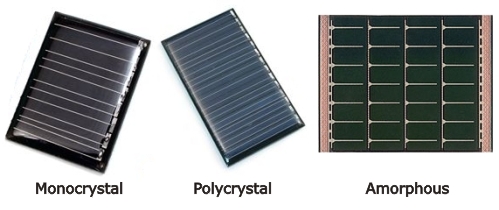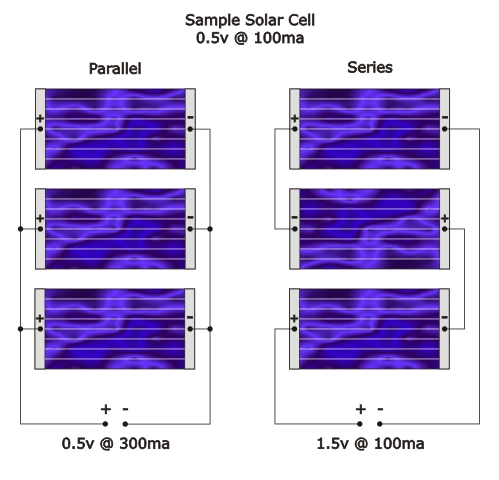| Intermediate Technology Education | Energy and Power Technology | Design Stage 2 | Topic 6 | Optional Activity 3 |
The Photovoltaic (Solar) Cell
- Measure the voltage output of a solar cell array
- Measure the current output of the array
- Use the array to power a wheeled vehicle
Photovoltaic Cells
As you learned in the activity Forms of Kinetic Energy, sunlight can be directly converted into electricity, mainly using devices made from the element silicon. They are usually called photovoltaic cells which gives a hint as to how they work on a large scale. Light bundles called photons cause a potential difference or voltage between the terminals of the cell. When connected to an external device with wires, the voltage causes a useful current to flow. The term solar cell is often used which indicates that the cell's primary source of energy is the star called Sol, which of course is the name of our sun!
The first great use of silicon photovoltaic cells was as the energy source for earth orbiting satellites, a role they still have. Today, solar cells can be found anywhere electricity is needed and not available through power distribution networks. Lighthouses, ocean buoys, park kiosks, environmental monitoring communication devices, cabins and cottages use solar cell arrays, which are becoming cheaper and more efficient as new manufacturing methods are developed.
There are many types of solar cells and ways of manufacturing them. The cheapest and most widely used are based on silicon and are available in three major categories.
- Monocrystaline—Made from silicon "grown" as a single crystal. Most expensive but most efficient ~ 25% efficiency
- PolycrystalineMolten—Silicon is cooled and the material develops crystals of various sizes. Cheaper than monocrystal but less efficient ~ 15% efficiency
- Amorphous—Silicon is deposited on some material (glass or plastic) from a silicon compound gas. Cheapest to manufacture, flexible, but least efficient ~ 10% efficiency

Figure. Three types of silicon solar cells
Connecting Cells
Solar cells like normal dry cells can be connected together to increase the voltage, current, or both. There are two ways to connect cells, Parallel and Series.
In Parallel, all the positive terminals of the cells are connected together as are all the negative terminals. The resulting current is the sum of the currents of each cell whereas the voltage is the same as a single cell. Also, there is more than one current path through the parallel arrangement.
In Series, the positive terminal of one cell is connected to the negative terminal of the next and so on. The resulting voltage is the sum of the voltages of the individual cells whereas the current is the same as a single cell. Also, there is only one current path through the series arrangement.
In a "nutshell", parallel increases the current and series increases the voltage.
In the next illustration, three solar cells each having a voltage of 0.5 volts and a current of 100 milliamperes are first connected in parallel and then in series. The resulting voltages and currents are shown.

Figure. Parallel and Series configuration for solar cells
For More information
For more information on these topics, check out these web pages
When you are ready, go to Your Turn